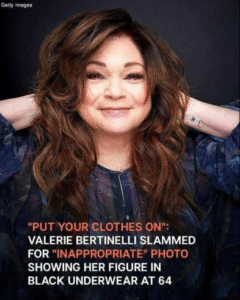Valerie Bertinelli and the Mirror Moment: A Reflection on Vulnerability, Judgment, and the Right to Be Seen
In early December 2024, Valerie Bertinelli—actress, author, and longtime advocate for self-acceptance—posted a mirror selfie on Instagram that ignited a storm of public reaction. The image, taken in a hotel bathroom, showed Bertinelli makeup-free, dressed in a black two-piece outfit, holding a box of hair dye. Her caption was not provocative, but deeply personal: “At some point I will talk about the madness my body has been through this year. But right now every lump bump wrinkle and saggy part of me just feels acceptance and simple appreciation to be standing in front of a mirror…”
For some, this was a moment of courage—a woman in her sixties reclaiming her body, her story, and her space. For others, it was “very inappropriate,” “attention-seeking,” or “disgusting.” The backlash was swift and, in many cases, cruel. Comments ranged from “Have you lost your mind posting this photo?” to “Why do we wanna see an old lady wearing her panties online?”
But beneath the noise lies something more profound: a cultural reckoning with aging, visibility, and the right to be unapologetically oneself.
The Mirror as a Metaphor
Valerie Bertinelli’s post was not just a selfie—it was a mirror held up to society’s discomfort with aging women who refuse to disappear. In a world that often demands silence and invisibility from older women, Bertinelli’s image was a quiet rebellion. She did not pose with glamour or seduction. She stood, bare-faced and honest, in a moment of mundane self-care. And yet, the reaction revealed how deeply ingrained our discomfort is with bodies that do not conform to youthful ideals.
Her caption spoke volumes—not just about her physical journey, but about emotional survival. “Every lump bump wrinkle and saggy part of me just feels acceptance…” That sentence alone is a manifesto. It’s not about vanity. It’s about survival. About standing in front of a mirror after a year of bodily “madness” and choosing gratitude over shame.
The Public Eye and Private Pain
Valerie Bertinelli has lived much of her life in the public eye. From her breakout role on One Day at a Time to her years as a Food Network host and Jenny Craig spokesperson, she has been both celebrated and scrutinized. Her body, in particular, has been a battleground—used to sell products, inspire weight loss, and invite commentary.
But what the public often forgets is that fame does not shield one from pain. In fact, it amplifies it. Bertinelli’s recent breakup with writer Mike Goodnough, reportedly due to concerns about his interest in her fame over her personhood, adds another layer of vulnerability to her recent post. It’s not just about showing skin—it’s about showing scars. Emotional, physical, and spiritual.
The Judgment Machine
The internet is a judgment machine. It rewards conformity and punishes deviation. And when a woman over 60 posts a photo in her underwear, the machine roars to life. “Grow up,” one commenter said. “Put your clothes on,” said another. These reactions are not just about Valerie—they’re about us. About our collective discomfort with aging, with vulnerability, and with the idea that self-love can exist outside of youth.
But Bertinelli did not back down. In a follow-up post, she wrote: “To all of you who sit in judgment of my body, the photo, and my reason for posting it, I hope you find a place in your heart to not judge yourself as harshly as you judge others.” That’s not defiance—it’s grace. It’s the kind of response that turns criticism into compassion.
The Ripple Effect of Courage
What Valerie Bertinelli did was not revolutionary in the traditional sense. She did not march, protest, or legislate. She stood in front of a mirror and said, “This is me.” And in doing so, she gave others permission to do the same.
For every cruel comment, there were voices of support. People who saw themselves in her vulnerability. Who felt seen, validated, and inspired. That is the ripple effect of courage. It does not always roar—it often whispers. But it moves people.
And for those who found her post “inappropriate,” perhaps the discomfort is worth examining. Why is a woman’s body only acceptable when it conforms to certain standards? Why is self-expression seen as attention-seeking when it comes from someone older? These are questions worth asking—not just of Valerie Bertinelli, but of ourselves.
Legacy, Not Likes
Valerie Bertinelli’s legacy will not be defined by a single photo. It will be defined by her decades of work, her resilience, and her willingness to be vulnerable in a world that punishes it. This moment, however, is a chapter worth remembering. Because it reminds us that legacy is not built on perfection—it’s built on authenticity.
In a culture obsessed with youth, Bertinelli’s post was a radical act of self-love. Not because it was provocative, but because it was honest. And honesty, especially from women who have been told to shrink, is revolutionary.
A Closing Thought
There’s a quiet power in standing in front of a mirror and saying, “I accept myself.” It’s not flashy. It’s not viral. But it’s healing. And in a world that often demands we hide our imperfections, Valerie Bertinelli chose to show hers. Not for likes, not for validation—but for liberation.
So let us not reduce this moment to controversy. Let us elevate it to conversation. About aging, dignity, visibility, and the right to be seen—not as objects, but as whole, complex, beautiful beings.


